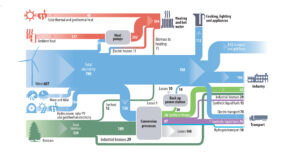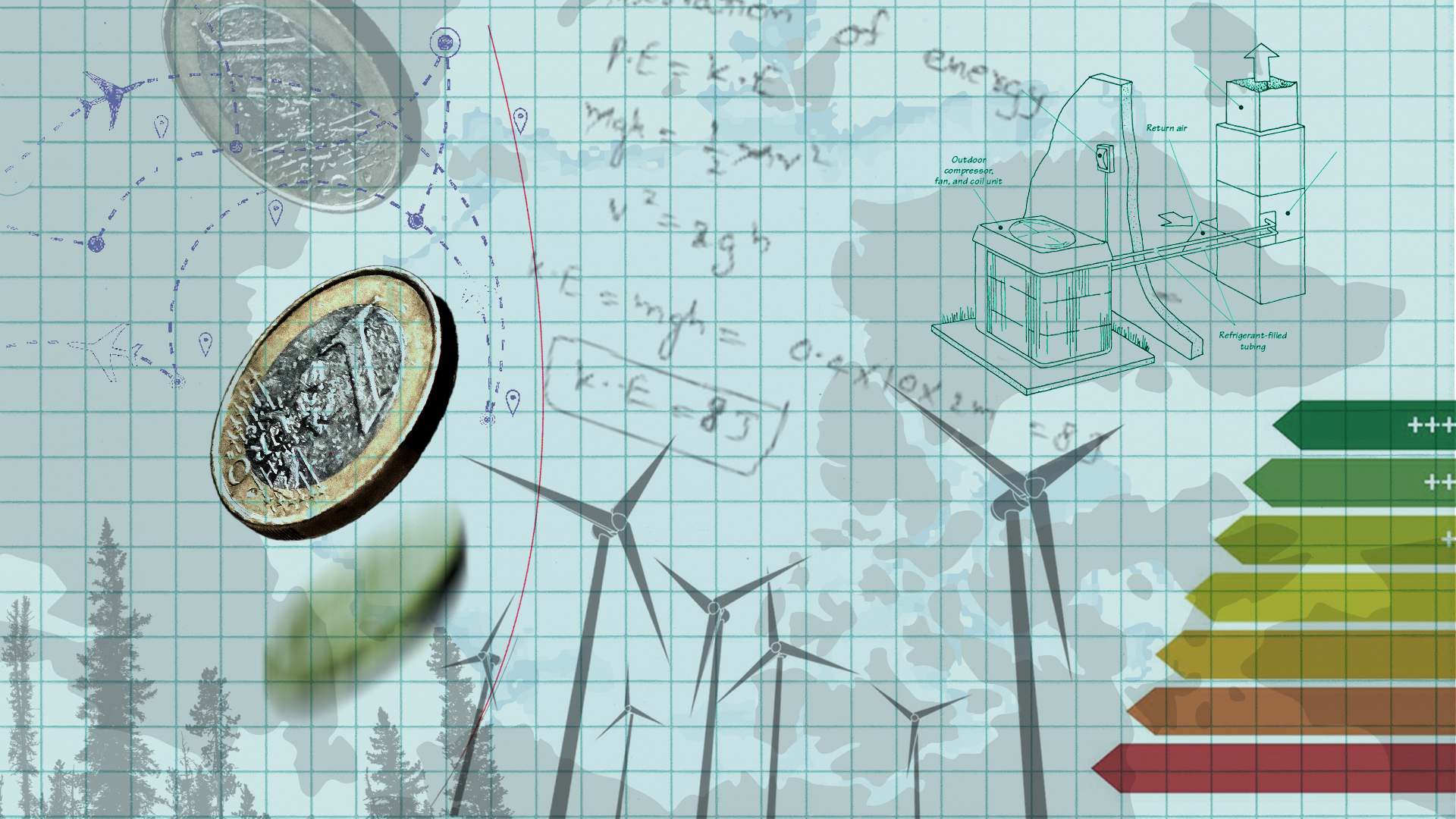The world is committed to achieving Net Zero by 2050 at the latest, aiming to limit global average temperature increases to 2℃ at worst by 2100, and in the best case 1.5℃ compared to pre-industrial baselines. Bear in mind that in the century since that baseline formed, the atmosphere has already warmed by more than 1 degree. So there’s very little headroom for increase, and none for complacency.
But let’s put climate politics aside for a while and focus instead on how we – individuals, communities, nations and countries – can create and adopt practical, effective solutions. Right at the heart of those solutions is energy: how much we consume, and how we generate it. It’s a good news story, so let’s start here.
We should talk about energy
Energy is such a useful word that gets used in all kinds of ways and contexts. So maybe it’s a good idea if we set a baseline for what this article means by energy.
Energy makes action happen
That action could be the flipping of a coin or the lighting of a lamp. The point is that energy can take many forms, but ultimately energy is energy is energy. Just that simple ability to make an action happen.
We’ve a longer primer here, if you need a bit more explanation
Zero Carbon and Net Zero
In the UK, total energy use creates about 80%[1]Centre for Alternative Technology. Zero Carbon Britain: Rising to the Climate Emergency. of our carbon emissions. This figure includes all energy used to heat, cool and light households, power business and industry, and fuel transport of all kinds. The majority of that energy still relies on fossil fuels. Renewables are generating around 43%[2] Department for Business, Energy and Industrial Strategy (DEIS): Digest of UK Energy Statistics 2020, via PV Magazine of electricity – and growing strongly – but electricity itself accounts for only around 20%[3]Department for Business, Energy and Industrial Strategy (DEIS). UK Energy In Brief 2021 of total energy consumed.
Renewables – and nuclear – produce energy and create no carbon. They are zero carbon technologies. Some areas of human activity – such as long haul travel and heavy transport – will be slow to decarbonise. Others might never get there – some industrial processes, parts of the construction sector and pastoral farming, for example. Net Zero envisages that those hard-to-eradicate emissions – though tangible, measurable and potentially harmful – are captured and stored away (sequestered). The carbon ledger balances at ‘net zero’ when remaining carbon emissions match carbon sequestered.
Better land management, made possible by changes in diet and food production, boosts the Earth’s capacity to sequester carbon, in trees, vegetation and in soil. Biodiversity benefits too. And some of that new biomass can be harvested and used as zero carbon fuel: because any carbon released through its use will be recaptured by the next ‘crop’ of biomass, trapped in a short, closed cycle.
Moonshots, mavericks and merry-go-rounds
Here’s the really good news. We already have all of the necessary technology for meeting our energy demand at zero carbon. More good news: the cost of that technology is plummeting. And if we can fix energy, we’re most of the way to Net Zero.
If you needed more good reasons to go hard for decarbonising energy, then think about this. The pace of climate change – the rate of increase in global average temperatures – is driven primarily by the total amount of carbon in the atmosphere, not the date fixed by diplomats for Net Zero. The earlier and the harder we cut, the better the long term outcome.
"It might come as a surprise to realise that all the know-how we need to decarbonise energy, we already have"
It might come as a surprise to realise that all the know-how we need to decarbonise energy, we already have. There’s a widely accepted narrative – a fairytale for our age – that every new challenge to our society, culture and progress needs some new breakthrough in science, technology and engineering to fix. The kinds of advancements in technologies and systems engineering that put humans on the moon, for instance. That’s how capital, markets and major industries are set up to perform. And it does Hollywood no harm either.
There will be new breakthroughs, but we don’t have to wait for them. And especially, we shouldn’t gamble on them. We just don’t need to.
It’s been proposed that some future industrial processes to strip CO2 directly from the atmosphere and store it safely – someplace – could be one such breakthrough. No one knows yet how efficiently this process could work, if it could scale cost-effectively, where the carbon would be stored, or whether the net contribution would be worth the effort. For reference in 2021, 36 trillion tonnes of new carbon was added to the atmosphere. In a slightly different take, how about a process to strip the carbon atoms from natural gas – a hydrocarbon – to create pure hydrogen? This so-called Blue Hydrogen is the brainchild of the fossil fuel industry. All of the reservations in the last paragraph apply. And we can’t not mention nuclear fusion. The recipe for fusion is to bang together two hydrogen atoms to create one helium atom, plus a lot of heat and a spare neutron: and repeat. Hydrogen can be made cleanly from water. Helium is the gas that floats party balloons. The heat makes steam, which turns turbines, which generates energy. The neutrons are captured and potentially reused too. Not a carbon atom in sight. Challenge: so far, no one has produced a fusion reactor that creates more energy than it consumes. There has been some more promising progress recently.
Moonshot tech – what you need to know
Long story short. We mustn’t give up on research, ingenuity and engineering. The merry-go-round of tech startups, investment, failures and successes will continue to spin. We’ve already witnessed how a maveric like SpaceX can reduce the cost of putting people and equipment into Earth orbit from $18,500 dollars per kilo for the Apollo missions, to less than $2,750 per kilo today, by building a totally re-usable rocket. Maybe someone else will do that for nuclear fusion, say.
But – cards on table – those kinds of engineering and cost optimisations are already delivering for wind and solar generation. For the UK, the cost per unit of offshore wind capacity has more than halved since 2016 – at a predicted £47[4]DEIS, via edie. ‘Government halves offshore wind forecasts.’ per MWh, making it some of the cheapest energy anywhere, and carbon free in use. It’s doubtful that any exotic new technologies will outcompete existing renewables, even by 2050.
So it’s vitally important that we don’t fall for the comforting fairy story, and put off for the next generation what our generation can easily afford to do today.
Energy Balance and Baseload
Exactly what we need to change, depends exactly on what we need to consume. The Centre for Alternative Technologies (CAT )in Machynlleth, Wales, is a long-established centre of excellence in the investigation and application of renewables, with a global reputation. In its Zero Carbon Britain: Rising to the Climate Emergency action plan, it has taken all of the many jigsaw pieces from technology, generation and consumption to create one possible picture of Net Zero – achievable by 2030, not 2050.
CAT’s approach is research driven, pragmatic and heavily evidence based. It understands better than almost anyone the imperative of cutting early, and the progressive impact on warming if targets creep.
In its balance of consumption and generation, it models a reduction in demand – Power Down – of 60% from 2017 levels. Behind that number is a lot of detailed analysis.
For instance, through very affordable improvements in insulation and heating controls in existing and new housing stocks, a 50% reduction in energy consumption is predicted. Energy use by industry has been falling steadily over decades too, because of more efficient technologies and processes.
Power Down also requires behavioural change from each of us. We have an opportunity to shrink the massive gap between our wants and our needs. Transport is a key area.
"With more use of public transport, walking, cycling, switching to efficient electric vehicles and two thirds less flying – would reduce energy demand for transport by 78%."
At this point, we’re inevitably drawn away from technology to sociology and politics once more. De-growing air travel should be part of government policy, but it’s also a choice that each of us can make. These are choices that will be harder on some of us than others: 1% of the world’s population produced half of aviation’s carbon[5]Journal of Global Environmental Change: ‘The global scale, distribution and growth of aviation: Implications for climate change’ emissions in 2018.
The beauty in the CAT model is that it is fully researched, and fully budgeted. So we get to see, with some precision, the impact we could collectively create by those shifts in behaviour.
In this case – and aside from the huge benefits of making sustainable reductions in emissions ‘ahead of schedule’ – what we get is a Power Up scenario in which the UK is powered entirely by renewable and carbon neutral energy sources, using affordable, available technologies, by 2030. There is no need for nuclear energy – which is also zero carbon – in this scenario. But more on that later. Plus the UK moves away from being a net importer of energy to energy self-sufficiency. In today’s geopolitical climate, that’s very important. In the CAT Power Up model, the energy mix and flow looks like this:
Centre for Alternative Technology: Energy flows from supply to demand ( figures in TWh )

The sun don’t shine every day
How do we generate when the sun isn’t shining? What do we do when the wind isn’t blowing?. These aren’t just talking points for windfarm nimbys – they’re genuine engineering questions. Any system based on renewables needs to harness smart technologies and processes to dynamically manage or shift demand. But we can also store surplus renewable energy until it’s needed. And we can convert it to solve gnarly emissions problems such as heavy and long haul transport. We’ll take a brief look at some of these in the final section.
Surplus renewable energy – when does that ever happen? Hourly weather data (sunlight, wind speed and temperature) collected by CAT over 10 years allows them to accurately model a surplus (in the PowerUp scenario above) 74% of the time. Efficient conversion of electrical energy to heat energy, chemical energy (hydrogen) and gravitational energy means it can be stored for leaner times, and accessed pretty much instantly.
Before then, it’s worth repeating that what we need to change depends on what we need to consume. In the CAT Power Down scenario from earlier – the 60% reduction in energy use – we don’t need to maintain fossil fuel or nuclear power stations in the mix for ‘baseload’ generation. "All paths to Net Zero require some kind of power down. All of them. The braver and more committed we are, the sooner we get there."
All paths to Net Zero require some kind of power down. All of them. The braver and more committed we are, the sooner we get there. And the fewer problematic technology choices we need to make. We’ve included some articles about choices and how to make them in Issue 55 of The Clec .
Tech in context
It’s not the job of this piece to detail all of the technologies in the renewables mix, but it’s worth highlighting some talking points. Again, Issue 55 signposts just a few helpful and interesting explainer articles.
Wind
The UK is one of those fortunate places gifted with strong and regular winds, onshore and offshore. Latest UK Government estimates predict the cost per megawatt hour (MWh) of offshore wind capacity built between now and 2030 at £47[6]DEIS, via edie. ‘Government halves offshore wind forecasts.’. Onshore wind is priced at £45[7]DEIS, via edie. ‘Government halves offshore wind forecasts.’. Over the same period, natural gas is expected to cost £82[8]DEIS, via edie. ‘Government halves offshore wind forecasts.’ per MWh. The cost of wind continues to fall. The cost of oil and gas continues to rise. Go figure.
Solar
The UK isn’t gifted with sunshine! But solar generation still makes a significant contribution and the cost of large scale solar electricity is predicted at £39[9]DEIS, via edie. ‘Government halves offshore wind forecasts.’ per MWh. Solar thermal makes a worthwhile contribution to heating hot water too. In places where the sun shines longer and stronger, solar generation is more cost effective than coal – even in markets where coal is heavily subsidised.
Nuclear
Engineers have found it hard to ignore E=mc2 – mass converting to energy at a ratio set by the speed of light (a huge number) squared. So far the only viable way to do this has been through splitting the atom in fission reactors – bringing significant problems of containment, accidents and waste. A really big deterrent is cost – around £95[10]DEIS, via edie. ‘Government halves offshore wind forecasts.’ per MWh. Earlier we looked at a power down/power up scenario that eliminated any need for nuclear power. That’s not so clear cut in less ambitious power downs. We are committed to solving the problems of containment, clean up and waste from previous generation of nuclear reactors. That being the case Small Modular Reactors, mass produced ( relatively) in factory conditions, might lower price and speed up availability of zero carbon nuclear energy without necessarily adding greatly to the existing clean-up challenge.
Hydrogen
Hydrogen has a big role to play in any future energy system. But it pays not to be colour blind. Green hydrogen is created through the electrolysis of water by surplus renewable electricity, resulting in zero carbon hydrogen and oxygen. CAT modelling shows that there could be a surplus of renewable electricity 74% of the time, so the creation of hydrogen is an effective way of storing that surplus for leaner moments. Green hydrogen can fuel longhaul aircraft and other energy intensive processes. And by combining it with carbon from biomass, you can make zero carbon synthetic fuels too. Blue hydrogen comes from a different process – the stripping of carbon molecules from natural gas. You can do the same with oil and coal, resulting in progressively more drab colour labels. It’s a controversial product, promoted heavily by the fossil fuel industry. Scale, cost and carbon content are all unproven.
Ambient and geothermal
This is about heat pumps. The idea behind an efficient heat pump is that for every unit of electrical energy you put in, you generate another four units of thermal energy for free, which can heat buildings and water. More on this here.
Gravity storage
Battery storage is rising dramatically, partly because the electric car market is booming. Prices are falling. There are older and simpler kinds of ‘batteries’too, based on potential energy. Pump storage schemes are some of the oldest. Surplus zero carbon power pumps water uphill to a storage facility. The water flows out through a turbine to generate power as it’s needed. They are efficient. They come on stream very quickly – which suits a renewables-based energy system. In The Clec Issue 55 we’ve linked to an even simpler and lower cost ‘gravitational battery’ story. Think clock weights…
Summary
The purpose of this article was to shine a light on practical, renewable energy generation and a possible recipe for zero carbon energy on route to overall Net Zero. Other recipes are possible, with different technology and cultural choices.
How would you feel now about building a mix of investment and regulation to halt warming at 1.5℃ by century’s end? The Climate Game – from the Financial Times – puts you in charge of Net Zero policy, for the whole world. Give it a try. It’s an eye opener.
And we highly recommend visiting the excellent Zero Carbon Britain hub at The Centre for Alternative Technology, where you’ll find a lot more information to help you make informed choices, and get into the debate wherever you are.
Whatever you do next, don’t do nothing. This thing is doable. It’s affordable. The tech is right here, right now. Go spread the good news.
References
| ↑1 | Centre for Alternative Technology. Zero Carbon Britain: Rising to the Climate Emergency. |
|---|---|
| ↑2 | Department for Business, Energy and Industrial Strategy (DEIS): Digest of UK Energy Statistics 2020, via PV Magazine |
| ↑3 | Department for Business, Energy and Industrial Strategy (DEIS). UK Energy In Brief 2021 |
| ↑4, ↑6, ↑7, ↑8, ↑9, ↑10 | DEIS, via edie. ‘Government halves offshore wind forecasts.’ |
| ↑5 | Journal of Global Environmental Change: ‘The global scale, distribution and growth of aviation: Implications for climate change’ |




What do you think?